 Suzuki Grand Vitara: Using the Transfer Switch (if equipped)
Suzuki Grand Vitara: Using the Transfer Switch (if equipped)
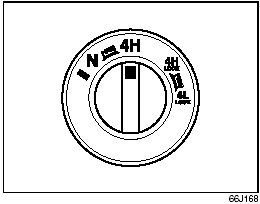
Using the Transfer
Switch (if equipped)
Your vehicle is equipped with a four-mode full-time 4x4 system. You can use the transfer switch to select any of the four modes: N, 4H, 4H LOCK, 4L LOCK.
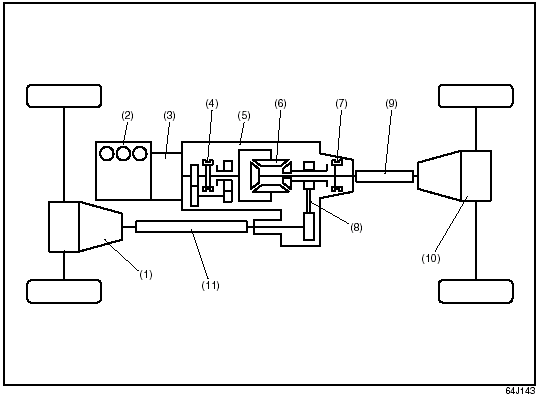 (1) Front differential
(2) Engine (3) Transmission (4) High/Low clutch (5) Transfer case (6) Center differential
(7) Differential lock clutch (8) Chain (9) Rear propeller shaft (10) Rear differential
(11) Front propeller shaft
(1) Front differential
(2) Engine (3) Transmission (4) High/Low clutch (5) Transfer case (6) Center differential
(7) Differential lock clutch (8) Chain (9) Rear propeller shaft (10) Rear differential
(11) Front propeller shaft
Description of Transfer Switch Positions
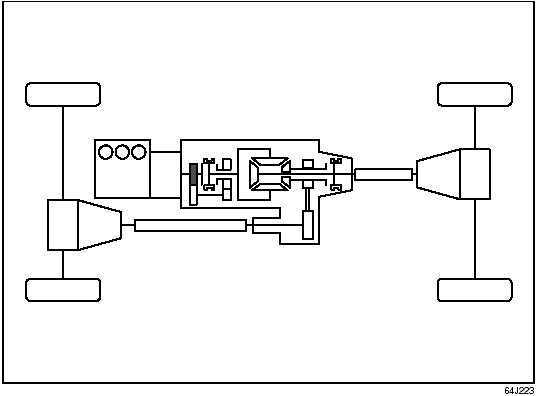
N (Neutral)
In this position, engine power is not supplied to the front or rear axles. Only use this position for towing your vehicle. When you turn the transfer switch to the “N” position, “N” indicator will come on with the buzzer sound.
 WARNING: Never leave the transfer
switch in “N” (Neutral) when parked. When the transfer switch is in “N” (Neutral),
the vehicle may roll even if the transmission is in gear or in Park.
WARNING: Never leave the transfer
switch in “N” (Neutral) when parked. When the transfer switch is in “N” (Neutral),
the vehicle may roll even if the transmission is in gear or in Park.
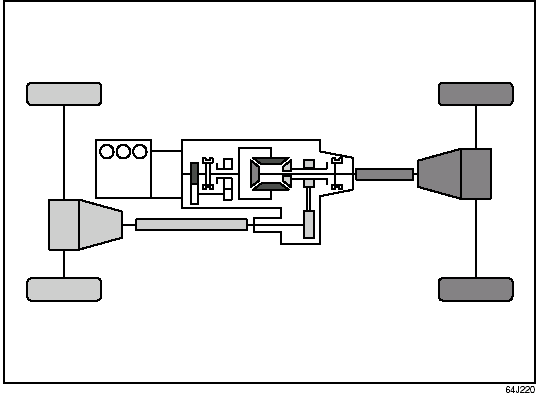
4H (4-wheel drive
high range)
In this position, engine power is supplied to the front and rear axles. Use this position for normal driving.
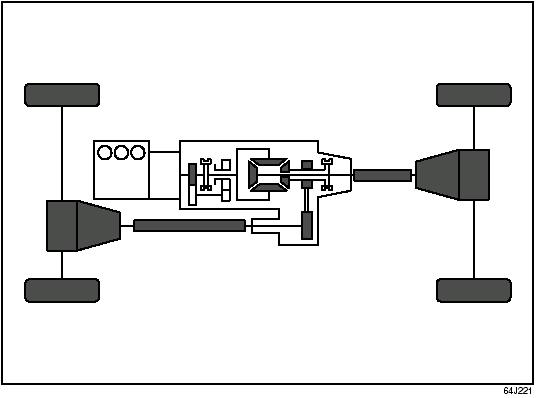
4H LOCK (4-wheel
drive high range center differential lock)
In this position, engine power is supplied to the front and rear axles and you get better traction than when driving in “4H”. Use this position when you need better traction than “4H” provides, such as when driving on slippery roads etc.
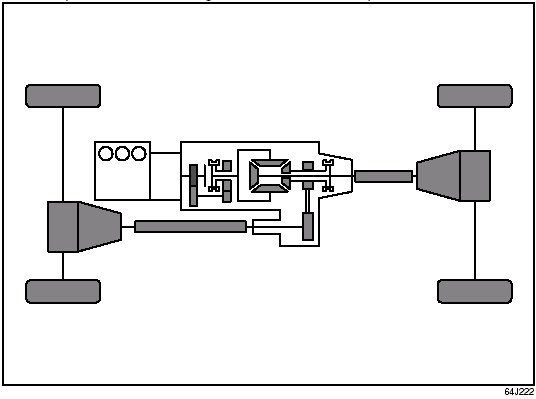
4L LOCK (4-wheel
drive low range center differential lock)
In this position, engine power is supplied to the front and rear axles and you get better traction and more low-speed torque than when driving in “4H”. Use this position when you need better traction than “4H” provides and more low-speed torque than “4H LOCK” provides, such as when climbing or descending steep, slippery hills etc.
NOTE: When the transfer switch (if equipped) is turned to the “4L LOCK” position, the ESP® systems (other than ABS) will be canceled to provide improved vehicle traction, and the “ESP OFF” indicator light will come on. When the transfer switch (if equipped) is turned to the “4L LOCK” position, braketraction control can be activated. Braketraction control brakes the spinning wheel to distribute drive power to the other wheels for increased climbing ability or for better performance on a rolling hill or a slippery surface.
ESP® is a registered trademark of DaimlerChrysler AG.
Transfer Switch Operation
Operate the transfer switch according to the appropriate procedure described below:
From N to 4H
Stop the vehicle completely, place the transmission in “N” (Neutral) and depress the brake pedal and the clutch pedal fully (if equipped), then push in and turn the switch to shift into “4H”.
From 4H to 4H LOCK
You can operate the transfer switch either when the vehicle is stopped or while the vehicle is moving. Position the front wheels straight ahead and turn the switch to shift into “4H LOCK”. If the vehicle is moving, we recommend that the speed be less than 100 km/h (60 mph) during this operation.
CAUTION: Do not operate the transfer switch while tires are racing.
NOTE:
• When shifting between the transfer switch position and the transfer gear position
is unmatched, all 4WD indicators will blink and the buzzer will sound.
• If it is difficult to shift between “4H” and “4H LOCK” while the vehicle is moving,
try accelerating and decelerating your vehicle several times after turning the transfer
switch. Be sure to wait until traffic conditions allow you to accelerate and decelerate
safety before using this procedure.
From 4H LOCK to 4L LOCK
Stop the vehicle completely, place the transmission in “N” (Neutral) and depress the brake pedal and the clutch pedal fully (if equipped), then push in and turn the switch to shift into “4L LOCK”.
From 4L LOCK to 4H LOCK
Stop the vehicle completely, place the transmission in “N” (Neutral) and depress the brake pedal and the clutch pedal fully (if equipped), then push in and turn the switch to shift into “4H LOCK”.
From 4H LOCK to 4H
You can operate the transfer switch either when the vehicle is stopped or while the vehicle is moving. Position the front wheels straight ahead and turn the switch to shift into “4H”. If the vehicle is moving, we recommend that the speed be less than 100 km/h (60 mph) during this operation.
CAUTION: Do not operate the transfer switch while tires are racing.
NOTE:
• When shifting between the transfer switch position and the transfer gear position
is unmatched, all 4WD indicators will blink and the buzzer will sound.
• If it is difficult to shift between “4H” and “4H LOCK” while the vehicle is moving,
try accelerating and decelerating your vehicle several times after turning the transfer
switch. Be sure to wait until traffic conditions allow you to accelerate and decelerate
safety before using this procedure.

From 4H to N
Stop the vehicle completely, place the transmission in “N” (Neutral) and depress the brake pedal and the clutch pedal fully (if equipped), then push in and turn the switch to the mark (1) at the left of the “N” position, and hold the switch in this posi- tion for 5 seconds until the “N” indicator blinks, then turn the switch to the “N” position. When you turn the transfer switch to the “N” position, “N” indicator will come on with the buzzer sound.
CAUTION:
• Be sure to stop the vehicle completely before operating the transfer switch to
shift between “N” and “4H”, or between “4H LOCK” and “4L LOCK”.
• Do not shift between “4H” and “4H LOCK” unless the front wheels are in the straight-ahead
position and we recommend that the vehicle speed be less than 100 km/h (60 mph).
Do not operate the transfer switch while tires are racing.
• Do not operate your vehicle in “4H LOCK” or “4L LOCK” on dry, hard surfaces.
• Do not operate the vehicle while a 4WD mode indicator is blinking except when
shifting between “4H” and “4L LOCK”. If you operate the vehicle while a 4WD mode
indicator is blinking, a buzzer will sound and the transfer will shift to “N” (Neutral)
to prevent transfer case damage. In this case, use the following procedure. 1) Depress
the clutch pedal fully (if equipped) or shift the automatic transmission gearshift
lever to the “N” position. 2) Turn the transfer switch to the position previously
selected. 3) Operate the transfer switch again.
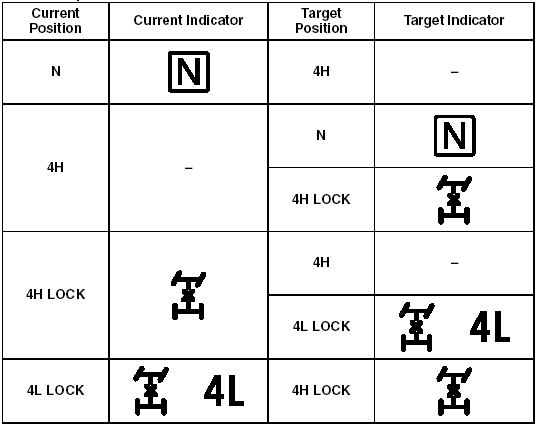
The basic operation
for transfer switch
 Using the Transmission
Using the Transmission
5-Speed Automatic
Transmission
D: 5-speed automatic transmission mode. 4: 4-speed automatic transmission
mode.
The 4-speed mode is suitable for the following driving conditions:
• Driving o ...
 Braking
Braking
Braking
The distance needed to bring any vehicle to a halt increases with the speed of
the vehicle. The braking distance needed, for example, at 60 km/h (37 mph) will
be approximately 4 times gr ...
See also:
Seat belts with pretensioners (front seats)
- The pretensioners cannot be reused
after activation. They must be replaced
together with the retractor
and buckle as a unit.
- If the vehicle becomes involved in a
collision but a prete ...
BAS (Brake Assist System)
Observe the "Important safety notes" section ().
BAS operates in emergency braking situations. If you depress the brake pedal
quickly, BAS automatically boosts the braking force, thus ...
Cleaning after off-road driving
Ensure that the areas around
air intakes
and the front grille are clean and clear of
debris. Pay particular attention to the
lower grille and radiator. Failure to do
so may cause the engine t ...
